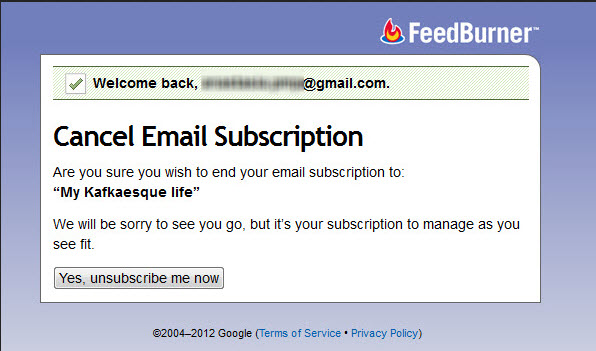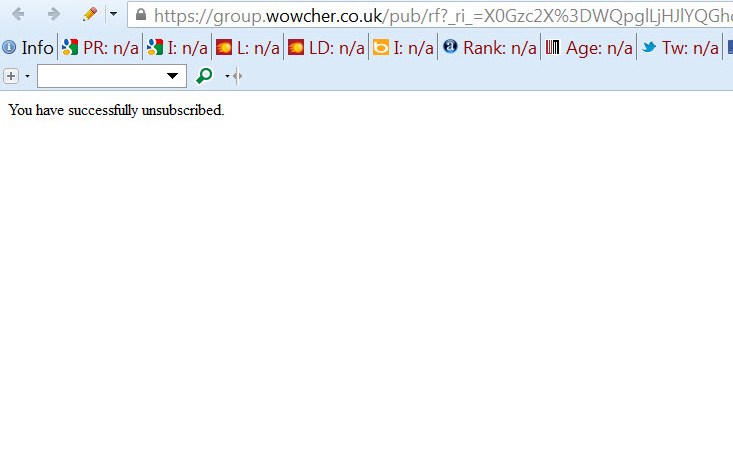How to correctly organize the process of unsubscribe

In the last post, we talked about how to correctly and correctly organize the subscription process on the site . If you have already organized the subscription process according to all the rules, then the reverse process will be quite simple.
Required line at the end of each letter
Everyone who is familiar with the rules of civilized mailing already knows the generally accepted rule Opt-out. Recall that it consists in the fact that the letter necessarily contains a link, following which the client can unsubscribe from the newsletter. In many countries, compliance with the opt-out rule is mandatory, and its violation is prosecuted . Therefore, put something like this at the beginning or at the end of the letter:

')
Notification Settings Panel
As we wrote in the previous post, setting up the unsubscribe process, you can create for each client their own space on your site, where they can regulate the subject of the letters they receive, the frequency of sending, and also delete your account. Then the link in the letter about which we spoke in the previous paragraph will look even more beautiful:

Are you sure you want to unsubscribe?
The FeedBurner mailing subscription mechanism uses an intermediate step, requesting confirmation before unsubscribing. This is a standard IT practice used in all applications. To tell the truth, this window seems to us the most convenient, again due to the fact that we once clicked on "unsubscribe" as an experiment - and in the end were not happy (read about it below).

Immediate reply
Often we are confronted with the immediate unsubscribe settings. As soon as a customer clicks on "unsubscribe" or "unsubscribe", he goes to the page with a single line - "your subscription has been canceled." This is what a link like this can look like - nothing special.

Then you immediately leave on a similar page:

This was the only inconvenient time - when subscribing to a chain of letters, which is essentially an anthology on a certain professional subject. Clicking on the link just for the test (by the way, when preparing this post) we dropped out of the thread, and had to sign again and start receiving all the letters from the beginning. However, this is the simplest way to unsubscribe from people who want to emphasize that sending them out is only on the merits and only when it is needed. Then selected concise as a samurai sword hit "one-click unsubscribe". In our opinion, such an answer is ideal if you are selling something.
We will be sorry to lose you
You already remember that after subscribing, your client should see “Thank you page”, which notifies him that he has successfully signed up and thanks. In the reverse process, they usually write “We're sorry to see you go” ... but, they say, nevertheless, you are unsubscribed from the newsletter. But! If you did everything correctly and honestly - you unsubscribed a person quickly and without problems, at this, perhaps the last meeting in your life, you can turn everything around. See how beautiful it is doing, for example, Skype:

There is not only the opportunity to contact support, but also the opportunity to start using the software again. You can use this pleasant example in order to make the farewell page, perhaps, again “meeting”.
How to return a client?
To begin, ask yourself: is it necessary? Your marketing department should look for new customers that you would be interested in. In addition, if you, for example, send out a newsletter to the visitors of your seminar, most likely, at the end of the seminar, all previous users will close their subscription, but new participants will sign up for new seminars. However, sometimes in such cases - if you report new events, for example, in the professional field, and do it at the proper level, your subscribers can continue to read you.
And yet, if you really for some reason would like to re-engage your former subscribers, you can send them 1 (one) letter, the content of which should be strictly regulated. This is an offer to subscribe to a new newsletter. This practice is extremely rare, and it can only work if it really offers what is interesting to the reader. However, this option should be used only in exceptional cases.
See also:
Good letters to you!
Source: https://habr.com/ru/post/151726/
All Articles